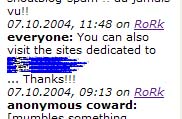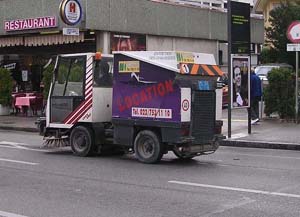San Francisco to expand free WiFi
Posted: October 22nd, 2004 | No Comments »An initiative by a polititician in San Francisco to make the Internet free to people. Now in Northern California, in a few years in the Universal Declaration of Human Rights:
“We will not stop until every San Franciscan has access to free wireless Internet service”
Changing Patterns of Creative Work
Posted: October 21st, 2004 | No Comments »Changing Patterns of Creative Work is the kind of “fast-food” reading I like (very much like the Totem Books “Introducing…”). Very originally structured. In this research notes about the Changing Patterns of Creative Work, the authors reports about the changing features characteristic of the creative class. 8 patterns are covered. In italic, the features in can related to.
Time
For this growing body of creative workers, their model of time resembles an integrated helix of work, life and play. There is no sense when creative workers turn on or off. A blend occurs across all their activities, and it is intention, not hour or location, that determines each creator’s chosen activity. Since they follow the flow of an idea, it is almost impossible to segment creative work.
Place
Creative workers, the office has lost its meaning. Access to mobile tools has removed the need to be tied to a location. Creative workers can think and create anywhere, anytime, since they move seamlessly between time, place and activity. They tend not to be defined by the place that they are in because they make time and space support their flow. They go where their ideas need to be or need to be found. Creative workers may use the office to catch up with colleagues or to coordinate large meetings, but most would rather meet in a location that brings the energy, social atmosphere and “tools” (a drink, a comfy couch, a breeze) that a collaborative event really demands (I wish I had that liberty!).
Technology
The office is in the creative workers’ pockets and on their backs.
Age
Creative workers are not defined by age
People
While creative workers are cosmopolitan, that does not mean they live only in cities – they exemplify itinerant. Creative workers move as they will. Whether it is a weekend somewhere else to draw inspiration,
another place that is hosting a small gathering of creatives, or a week away every year to read and review everything important, creative workers cannot be found by looking at location.
Economics
There is growing recognition that “the relatively well educated and relatively creative are disproportionately important” to economic growth. Creative workers face the metric challenge every day. “Solving the problems of knowledge worker productivity and performance is a daunting prospect.
Marketing
Demographics cannot find creative workers.
Community
Now, more regions are recruiting individuals, not necessarily businesses. Regions are being challenged to attract the people who then will attract companies. The bottom line is that city leaders and politicians must create a people climate, as well as business climate. Creative workers are easily able to migrate. While some may be sentimental about certain places, most are eager to find an energizing and supportive place for their passions.
Location de Balayeuse
Posted: October 21st, 2004 | No Comments »Via Maître Grévin de Dried Boogers, une balayeuse de location, the perfect birthday gift:
Relation Designeur-Utilisateur
Posted: October 21st, 2004 | No Comments »Notes du premier cours HCI à TECFA. Les différences entre les besoins et les fonctionnalités, ainsi que la relation utilisateur-designer ont été abordées:
Changement de paradigme depuis 1994
- le site ne doit plus être expliqué
- structuration de l’information
- information dynamique
- infomration venant de l’exterieur
- d’accès plus abondant aux sous-branches
- le focus est sur les actions que peuvent faire les utlisateurs
- on est passé de l’offre à l’expérience des utilisateurs (pas comment on vend, mais comment on achete)
Avant:
- fonctionalités et technologies (technology-centered approach)
Mainenant:
- construction des modèes, des scéarios pour après construire les fonctionalités, retour aux utilisateurs et developpment des concepts visuels ( User-centered design)
User-centered design
1er modèle
- les besoins, tout ce que l’on veut
2ème modèle (le compromis)
- specification pour client contraintes technologiques
puis: Créer des profiles d’utilisateurs (population d’utilisateur) -> Genération de scenarios -> Nourrire l’interface avec les scenarios -> Smulation et prototype -> Retour à l’utilisateur (tous les changements doivent etre validés par les utilisateurs)
Quel besoins?
- tous les niveaux de la pyramide de Maslow
- expression des besoins (besoins observables, explicites, tacites et émergents)
Besoins Vs Fonctionalités
Ne pas mélanger le besoin de l’utilisateur et la solution du designer (j’ai besoin d’une alarme). L’utiliseur peut utiliser des mots qui ne représente pas la solution à ses besoin. Il ne faut pas faire une liste de fonctionnalité, mais une liste de besoins. Par contre, on peut trouver le besoin à travers la fonctionnalité. En fonction des besoins on peut créer le profile d’utilisateur, puis apres faire les fonctionalités.
Question projet Vs Question utilisateur
Question project “créeun un environnment virtuel pour l’enseignement du français au niveau primaire”
Quetion utilisateur “Comment j’apprends le français”
Interview: Comprendre l’expérience des utilisateurs et déterminer leur besoins. L’utilisateur est l’expert.
Playing CatchBob! on Tablet PC
Posted: October 19th, 2004 | Comments OffA snapshot of Nicolas playing CatchBob! on Tablet PC.
Reallocating Time and Money into Inconspicuous Goods
Posted: October 18th, 2004 | No Comments »Via Wired, from Deadalus, volume 133, issue 2:
“Evidence suggests that if we use an increase in our incomes, as many of us do, simply to buy bigger houses and more expensive cars, then we do not end up any happier than before. But if we use an increase in our incomes to buy more of certain inconspicuous goods – such as freedom from a long commute or a stressful job – then the evidence paints a very different picture… Reallocating our time and money in these and similar ways would result in healthier, longer – and happier – lives.“
CatchBob! Smartmobbed
Posted: October 11th, 2004 | Comments OffA few minutes after the CatchBob project page had been online, it has been smartmobbed.
ShoutBlog Spam
Posted: October 9th, 2004 | No Comments »After more than one year of existence, the ShoutBlog unexpectedly received its first spam message. A sign of maturity?









